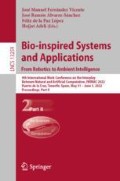Abstract
Pedestrian detection is an important task addressed in computer vision given its direct application in video surveillance, autonomous driving and biomechanics among many others. The advent of deep neural networks has meant a breakthrough in its resolution. The major problem is the need for very large labeled datasets, which is usually difficult to obtain, either because it is not publicly available or it is not suitable for the particular problem. To solve it, we design a method capable of self-labeling a detection dataset using only small manually labeled portion of it. Results show an autolabeled dataset of 10342 images from a preliminary set of 1312 manually labeled images.
Access this chapter
Tax calculation will be finalised at checkout
Purchases are for personal use only
References
Dollár, P.,Wojek, C., Schiele, B., Perona, P.: Pedestrian detection: an evaluation of the state of the Art. PAMI 34 (2012)
Chen, K., et al.: MMDetection: Open MMLab Detection Toolbox and Benchmark, arXiv preprint arXiv:1906.07155 (2019)
Deng, J., Dong, W., Socher, R., Li, L. J., Li, K., Fei-Fei, L.: ImageNet: a large-scale hierarchical image database. In: CVPR (2009)
Howard, A.G., et al.: Mobilenets: efficient convolutional neural networks for mobile vision applications. arXiv preprint arXiv:1704.04861 (2017)
Zhang, X., et al.: ShuffleNet: an extremely efficient convolutional neural network for mobile devices. In: CVPR (2018)
Tan, M., Le, Q.: EfficientNet: rethinking model scaling for convolutional neural networks. In: ICML (2019)
Ramirez, I., et al.: Convolutional neural networks for computer vision-based detection and recognition of dumpsters. Neural Comput. Appl. 32 (2020)
Gao, Y., Ma, J., Yuille, A.L.: Semi-supervised sparse representation based classification for face recognition with insufficient labeled samples. IEEE Trans. Image Process. (2017)
Paul, M.K., Pal, B.: Gaussian mixture based semi supervised boosting for imbalanced data classification. In: Proceedings of the 2nd International Conference on Electrical, Computer Telecommunication Engineering (ICECTE) (2016)
Li, Y.F., Zhou, Z.H.: Towards making unlabeled data never hurt. PAMI (2015)
Zhang, R., Rudnicky, A.I.: A new data selection principle for semi-supervised incremental learning. In: ICPR (2006)
Liu, S., et al.: A novel data augmentation scheme for pedestrian detection with attribute preserving GAN. Neurocomputing (2020)
Huang, S., Ramanan, D.: Expecting the unexpected: training detectors for unusual pedestrians with adversarial imposters. In: CVPR (2017)
Hooker, S., Dauphin, Y., Courville, A., Frome, A.: Selective Brain Damage: Measuring the Disparate Impact of Model Pruning. arXiv preprint arXiv:1911.05248 (2019)
Northcutt, C.G., Jiang, L., Chuang, I.: Confident learning: estimating uncertainty in dataset labels. J. Artif. Intell. Res. 70, 1373–1411 (2021)
Shankar, V., Roelofs, R., Mania, H., Fang, A., Recht, B., Schmidt, L.: Evaluating machine accuracy on ImageNet. In: International Conference on Machine Learning (ICML) (2020)
Northcutt, C.G., Athalye, A., Mueller, J.: Pervasive label errors in test sets destabilize machine learning benchmarks. In: Proceedings of the 35th Conference on Neural Information Processing Systems (NeurIPS 2021) Track on Datasets and Benchmarks (2021)
Acknowledgements
This research has been supported by the Spanish Government research funding RTI2018-098743-B-I00 (MICINN/FEDER) and the Comunidad de Madrid research funding grant Y2018/EMT-5062.
Author information
Authors and Affiliations
Corresponding author
Editor information
Editors and Affiliations
Rights and permissions
Copyright information
© 2022 Springer Nature Switzerland AG
About this paper
Cite this paper
Garcia-Espinosa, F.J., Montemayor, A.S., Cuesta-Infante, A. (2022). Automatic Annotation for Weakly Supervised Pedestrian Detection. In: Ferrández Vicente, J.M., Álvarez-Sánchez, J.R., de la Paz López, F., Adeli, H. (eds) Bio-inspired Systems and Applications: from Robotics to Ambient Intelligence. IWINAC 2022. Lecture Notes in Computer Science, vol 13259. Springer, Cham. https://doi.org/10.1007/978-3-031-06527-9_30
Download citation
DOI: https://doi.org/10.1007/978-3-031-06527-9_30
Published:
Publisher Name: Springer, Cham
Print ISBN: 978-3-031-06526-2
Online ISBN: 978-3-031-06527-9
eBook Packages: Computer ScienceComputer Science (R0)

